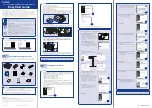
Part 2 Basics of the LPX-250
14
Rescanning
In general, increasing the number of scanning surfaces results in greater scanning precision with correspondingly fewer conspicuous seams.
In the example of the doll, however, only one of the five scanning surfaces can capture the voids. From the standpoint of capturing voids,
two surfaces are more effective.
Scanning surfaces: 5
Scanning surfaces: 2
4. Rotary Scanning
Features of Rotary Scanning
This mode scans the outer perimeter of the scan object while rotating the table in one direction. This is suited to scanning objects that have
relatively little unevenness and are close in shape to a sphere or cylinder, and lets you perform smooth scanning for curved surfaces.
It is more selective of the shape of the object than plane scanning, but conversely reproduces smooth curves even at relatively coarse pitches,
and also takes less time. Capturing cavities and voids in objects is more difficult than with plane scanning.
Finishing by Rescanning
If the object is highly uneven, there may be many areas that the laser light does not reach. Rotary scanning is more likely to be affected by
this than plane scanning, and may result patches that are not scanned. With rotary scanning, you can finish such areas by rescanning.
Perform rotary scanning for the entire object, then rescan only the areas you want to finish. This enables scanning with an attractive finish
even for detailed portions while smoothly reproducing the curved features of the entire object.
Rotary scanning system
The laser beam is emitted
toward the center of the table.
















































